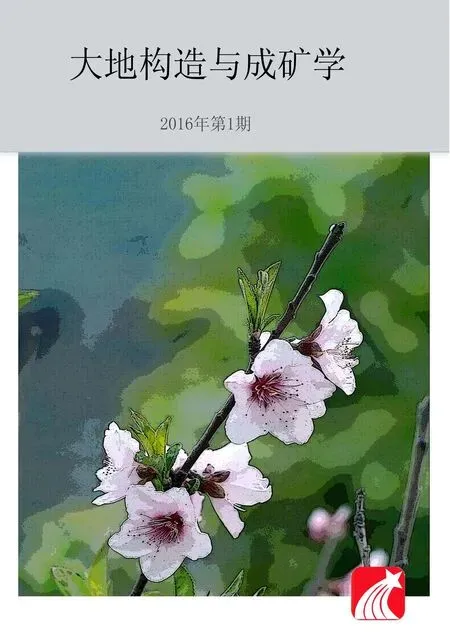济南辉长岩岩浆演化过程: 来自熔体包裹体的证据
丁相礼, 任钟元, 郭 锋, 钱生平, 2, 张 乐, 黄小龙,陈林丽, 张银慧, 洪路兵, 张 艳, 2, 吴亚东, 2
(1.中国科学院 广州地球化学研究所, 同位素地球化学国家重点实验室, 广东 广州 510640; 2.中国科学院大学, 北京 100049; 3.中国科学院 青藏高原研究所, 北京 100101)
济南辉长岩岩浆演化过程: 来自熔体包裹体的证据
丁相礼1, 2, 3, 任钟元1*, 郭 锋1, 钱生平1, 2, 张 乐1, 黄小龙1,陈林丽1, 张银慧1, 洪路兵1, 张 艳1, 2, 吴亚东1, 2
(1.中国科学院 广州地球化学研究所, 同位素地球化学国家重点实验室, 广东 广州 510640; 2.中国科学院大学, 北京 100049; 3.中国科学院 青藏高原研究所, 北京 100101)
摘 要:本研究首次报道了早白垩世济南辉长岩中橄榄石斑晶捕获的熔体包裹体的研究结果。济南辉长岩中橄榄石的Fo(60.3~74.6), Mn(2500~3500 μg/g), Ni(70~1349 μg/g), Fe/Mn比值(61.2~83.5), 与源区母岩为纯的橄榄岩形成的熔体结晶出的橄榄石性质不同, 可能与源区存在辉石岩的贡献有关。橄榄石中熔体包裹体主量元素具有较大的变化范围。熔体包裹体成分的标准矿物计算(CIPW)表明, MgO>10%的熔体包裹体为含有霞石和橄榄石标准矿物分子的硅不饱和熔体,MgO<10%时为含石英标准矿物分子的硅饱和熔体。橄榄石中包裹有辉石和斜长石, 说明岩浆演化过程应该处于开放环境。熔体包裹体的(208Pb/206Pb)i和(207Pb/206Pb)i与MgO具有良好的负相关关系, 与SiO2具有良好的正相关关系, 以及熔体包裹体具有较高的SiO2特征表明岩浆演化过程中可能有下地壳长英质组分的加入。熔体包裹体的Pb同位素落在EMI附近并向EMII延伸, 其源区可能有EMI和EMII的贡献, 熔体包裹体的主量元素成分说明其源区母岩可能有橄榄岩和辉石岩的贡献。
关键词:济南辉长岩; 橄榄石; 熔体包裹体; Pb同位素
项目资助: NSFC重大研究计划(91214202, 90714001)和“百人计划”择优项目联合资助。
0 引 言
华北克拉通是世界上最古老的的克拉通之一,记录的最古老的下地壳捕掳体年龄约为3.8 Ga(Liu et al., 1992), 与世界典型的克拉通形成于太古代的年龄相似(Aulbach et al., 2004, 2005, 2007)。华北陆块在古元古代东、西部陆块的碰撞拼合作用之后形成稳定的克拉通。基于华北中新生代地幔包体的岩石学、地球化学研究表明, 华北克拉通岩石圈地幔发生了大规模的减薄, 且岩石圈地幔性质发生了转变。目前, 对于华北克拉通破坏这一事实基本上取得了共识, 但对于克拉通破坏的机制仍存在争论。华北克拉通破坏的机制存在如下的争论: 热-机械化学侵蚀作用(Griffin et al., 1998; Menzies and Xu,1998; Fan et al., 2000; Guo et al., 2001; Xu, 2001; 范蔚茗和郭锋, 2005; Menzies et al., 2007); 拆沉作用(邓晋福等, 1994; Gao et al., 2002, 2004; Wu et al.,2003; Xu et al., 2006; Deng et al., 2007; Yang et al.,2008; Liu et al., 2008); 橄榄岩-熔体相互作用(Zhang et al., 2002, 2008; 张宏福等, 2004; Tang et al., 2006;张宏福, 2009); 岩浆提取作用(Chen et al., 2004); 岩石圈地幔水化(牛耀龄, 2005)以及地幔柱模式(Qian et al., 2015)。华北克拉通破坏的动力学背景或控制因素存在如下争论: 东侧太平洋板块的俯冲作用(Griffin et al., 1998; 牛耀龄, 2005; Wu et al., 2005,2006; Zheng et al., 2006; Qian et al., 2015); 来自南侧扬子板块向华北板块的俯冲碰撞作用(Menzies and Xu, 1998; Gao et al., 1998, 2004; Xu, 2001; Zhang et al., 2002; Xu et al., 2004, 2005; Wu et al., 2006;Yang et al., 2008); 印度板块同欧亚大陆碰撞的远程影响(Menzies et al., 1993; Liu et al., 2004a); 多方位板块俯冲(Zhang et al., 2003; Zhai et al., 2007)。
华北克拉通中生代岩浆活动是克拉通破坏的浅部响应, 因此研究克拉通的岩浆活动可以反演克拉通破坏过程中的岩浆演化过程。华北克拉通中生代以来发育了大规模的岩浆活动, 白垩纪之前的岩浆活动较少且大多数为酸性、中性岩浆活动, 而基性岩浆活动很少, 主要分布于克拉通的边缘。到白垩纪岩浆活动的范围和强度达到顶峰, 并在克拉通的腹地出现, 酸性和基性岩浆均有出现。基性岩浆通常被认为由地幔熔融形成, 因此可以用来反演地幔性质, 为此我们选择对中生代基性岩石进行研究。
华北克拉通研究已取得了丰富的成果, 但是前人研究主要集中在全岩主微量、同位素, 只有部分学者采用了单矿物成分及同位素分析。但是全岩只能记录部分熔融形成的熔体经历一系列复杂的岩石学过程后(岩浆混合、结晶分异、岩浆去气和围岩的同化作用等)的成分变化(Sobolev, 1996; Sobolev et al., 2000; Ren et al., 2005; 刘建强和任钟元, 2013),关于岩石成因方面的重要信息变得模糊或消失。而熔体包裹体是矿物在结晶的过程中捕获的岩浆小滴,它可以记录原生岩浆及其演化过程中的岩浆信息(Sobolev, 1996; Norman et al., 2002; Ren et al.,2005)。因此通过熔体包裹体的研究可以更有效制约华北克拉通的深部岩浆过程。
1 区域地质背景
华北克拉通位于中国中-东部, 秦岭-大别-苏鲁超高压变质带的北侧, 东邻太平洋板块, 北部为中亚造山带(图1a)。以南北重力梯度线为界分为东部板块和西部板块, 两者在早元古代(2.0~1.8 Ga)时发生碰撞, 形成中央造山带(Zhao et al., 2001)。山东可以根据郯庐断裂带分为鲁西和鲁东两部分, 鲁西地区北临渤海, 东南部与苏鲁高压超高压变质带相邻。鲁西地区在早白世垩沿郯庐断裂带发育了大规模的岩浆活动, 主要有济南和沂南辉长岩侵入体(约130~134 Ma, Huang et al., 2012; Guo et al., 2013), 邹平辉长岩类杂岩体(~128 Ma, Huang et al., 2012), 淄博闪长岩岩体(~128 Ma, 钟军伟和黄小龙, 2012)、枣庄龙宝山碱性岩体(~129 Ma, Huang et al., 2012)及费县(~119 Ma, Gao et al., 2008)和方城(~125 Ma, Zhang et al., 2002)玄武岩。
济南岩体位于华北克拉通东部的济南-郭店一带, 郯庐断裂带西侧, 为中-基性杂岩体, 主要岩石类型为辉长岩类、闪长岩类和正长岩类。主要侵位于奥陶系、石炭系、二叠系, 多数被第四系覆盖, 露头零星出露, 主体呈EW向展布, 长~45 km, 宽~20 km,总面积~464 km2, 以济南地区出露最广(山东省地质矿产局, 1991)(图1b)。根据岩体之间的穿插关系、岩石和矿物特征, 可以将济南岩体划分为三个期次,第一期为济南岩体的主岩体包括匡山、标山、凤凰山、卧牛山、无影山等, 主要分布于济南市区附近;第二期主要出露在沙沟、于山等地, 分布于郭店一带; 第三期出露在药山一带。本文研究的样品分布在匡山(09SD-2, 09SD-4)、标山(09SD-15)和卧牛山(09SD-23), 它们均属于济南岩体的主岩体(图1b)。济南岩体的锆石和斜锆石U-Pb年龄为130~134 Ma (Guo et al., 2013), Huang et al. (2012)报道的锆石U-Pb年龄为127.5±2.2 Ma。

图1 华北克拉通构造简图(a), 济南岩体区域地质简图和采样点位置(b, 据Zhao et al., 2001; 山东省地质矿产局, 1991)Fig.1 Simplified tectonic framework of the North China Craton (a), and geologic sketch map of the Jinan gabbros andsample locations (b)
2 样品与测试方法
本文选取Guo et al. (2013)报道过橄榄石成分和O同位素的09SD-2、09SD-4、09SD-15和09SD-23四个样品进行熔体包裹体研究。四个样品均为辉长岩, 采样位置见图1b。岩石薄片中可见有橄榄石、辉石、斜长石和钛铁矿, 部分橄榄石中包裹有辉石、斜长石, 辉石中包裹有斜长石(图2)。四个样品均比较新鲜, 橄榄石未发生蚀变。四个样品的成分变化范围为: SiO2(47.91%~49.75%), MgO(12.32%~14.67%),FeO(8.95%~12.14%), CaO(10.6%~11.09%), Al2O3(11.43%~12.1%), Na2O(1.62%~1.8%), K2O(0.28%~0.43%),TiO2(0.4%~0.74%)。Guo et al. (2013)已经对全岩的主微量, 锆石和斜锆石的Hf、O同位素, 橄榄石成分及O同位素进行了分析, 我们在其研究的基础上对橄榄石成分及其中熔体包裹体成分进行了分析, 并测试了橄榄石中熔体包裹体的Pb同位素组成。
我们对四个样品分别进行了粉碎, 并用去离子水进行清洗, 105 ℃烘干。随后筛选60~80目粉末样约50 g, 双目镜下挑选新鲜橄榄石400粒。在QFM条件下对橄榄石进行加热, 加热温度为1180 ℃, 在加热炉中持续加热10 min, 取出, 在空气中淬冷,使其中的熔体包裹体均一化。将加热后的橄榄石镶嵌在直径约为1 cm的树脂靶上, 对其进行打磨、抛光, 使熔体包裹体出露在树脂靶的平面上; 再将磨出包裹体的树脂靶镶嵌在直径约为2.5 cm的树脂靶上。以上实验是在中国科学院广州地球化学研究所(GIG-CAS)同位素地球化学国家重点实验室熔体包裹体实验室完成, 详细的熔体包裹体的制备方法见Ren et al. (2005)。
橄榄石和熔体包裹体化学成分分析是在GIG-CAS同位素地球化学国家重点实验室JEOL JXA-8100型电子探针上完成的。橄榄石化学成分的测试条件与Sobolev et al. (2007)方法相似, 具体条件为: 加速电压为20 kV, 电流为300 nA, 束斑直径2 μm。Mg、Si、Fe三种元素的计数时间为90 s, Ca 和Mn计数时间为120 s, Ni的计数时间为150 s。熔体包裹体化学成分的测试方法与Wang and Gaetani (2008)相似, 具体条件: 加速电压为15 kV, 电流为20 nA, 束斑直径为3 μm。分析过程中Na、K容易丢失, 为了降低这种丢失, 优先对Na、K进行分析。每一次换样之后都对内标进行测定来监测仪器的运行状态。数据采用 ZAF 修正法进行修正, 采用美国SPI 公司的标样校正。为了监控仪器的漂移效应,每批样品测定前后需要测定监控标样。其中橄榄石监控标样的相对分析精度: 主量元素(MgO、FeO和SiO2)小于0.4%, 痕量元素(CaO、MnO和NiO)小于3%; 包裹体测试时玻璃监控标样 JB-2 的相对分析精度: 大部分主量元素小于0.5%, MnO, K2O 和P2O5分别为5%, 1%和8%。
熔体包裹体的 Pb 同位素组成是在GIG-CAS同位素地球化学国家重点实验室的激光剥蚀-多接受等离子体质谱仪(LA-MC-ICPMS)上完成的。首先将上述已经完成主量元素分析的熔体包裹体大靶重新进行抛光, 抛除熔体包裹体表面残余碳粉, 挑选出直径大于40 μm的熔体包裹体重新制靶抛光, 然后将新靶置于超声波清洗槽中分别用1%的稀HNO3和Milli-Q水各超声2遍, 每次超声10 min。超声完成以后晾干置于一旁待测。激光工作参数:激光波长193 nm, 束斑直径45 μm; 频率3 Hz; 能量80 mJ; 能量通量50%; 单点激光剥蚀时间为30 s;背景测试时间为30 s; 激光池载气(He)流量, 80 ml/min;氮气, 2 ml/min。测试过程中质谱采用的接收器阵列同时接收了U、Th和Pb的信号强度, 根据测试的U/Pb和Th/Pb比值来校正U和Th放射性衰变对Pb同位素的影响, 详细的分析方法见Zhang et al. (2014)。
3 结 果
3.1橄榄石化学成分
我们共获得了四个样品中的98个橄榄石数据和47个熔体包裹体数据。橄榄石的Fo介于60.3~74.6, 与Guo et al. (2013)报道的(57.8~73.1)相似。具有较低的CaO含量(<0.1%), 较低的Mn(2500~3500 μg/g), 较高的Ni(70~1349 μg/g), Fe/Mn比值在61~83(表1)。部分Fo较低(<66)的橄榄石中包裹有单斜辉石和斜长石(表2, 图2)。
3.2橄榄石中熔体包裹体的化学成分
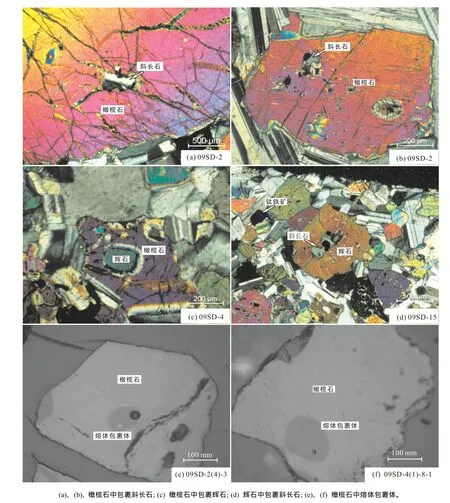
图2 济南辉长岩和熔体包裹体的显微照片Fig.2 Micro-photographs of the Jinan gabbros and melt inclusions
橄榄石中熔体包裹体的主量元素(SiO2、FeO、CaO、Al2O3、Na2O、K2O)变化较大(表3), 但与MgO具有相关性(图3), 而Ni、Mn、P及易挥发元素(S、F、Cl)与MgO无相关性。橄榄石中熔体包裹体的成分与全岩相比表现出更宽的变化范围(图3)。SiO2与MgO总体上呈现负相关关系。K2O(0.45%~2.16%)变化范围较大, 且随MgO降低而升高。当MgO>10%时, FeO、CaO、Al2O3、TiO2基本不随MgO变化而变化, 而MgO<10%时, FeO、CaO、TiO2与MgO呈正相关, Al2O3与MgO呈负相关(图3)。
3.3熔体包裹体Pb同位素
共测试了19个直径>40 μm的熔体包裹体的Pb同位素。经过U和Th衰变校正后的熔体包裹体Pb同位素: (208Pb/206Pb)i=2.0927~2.1742, (207Pb/206Pb)i= 0.8535~0.8984(表4), 与全岩Pb同位素组成基本落在同一趋势上(图4)。熔体包裹体和全岩的Pb同位素都落在EMI附近, 有向EMII延伸的趋势。与全岩相比, 熔体包裹体的(208Pb/206Pb)i、(207Pb/206Pb)i具有更大的变化范围且较全岩偏低。熔体包裹体的MgO与(208Pb/206Pb)i和(207Pb/206Pb)i呈负相关, SiO2与(208Pb/206Pb)i和(207Pb/206Pb)i呈正相关(图5)。MgO含量较高的熔体包裹体具有较低的(208Pb/206Pb)i和(207Pb/206Pb)i, 偏离EMI区域, EMII的贡献较大。
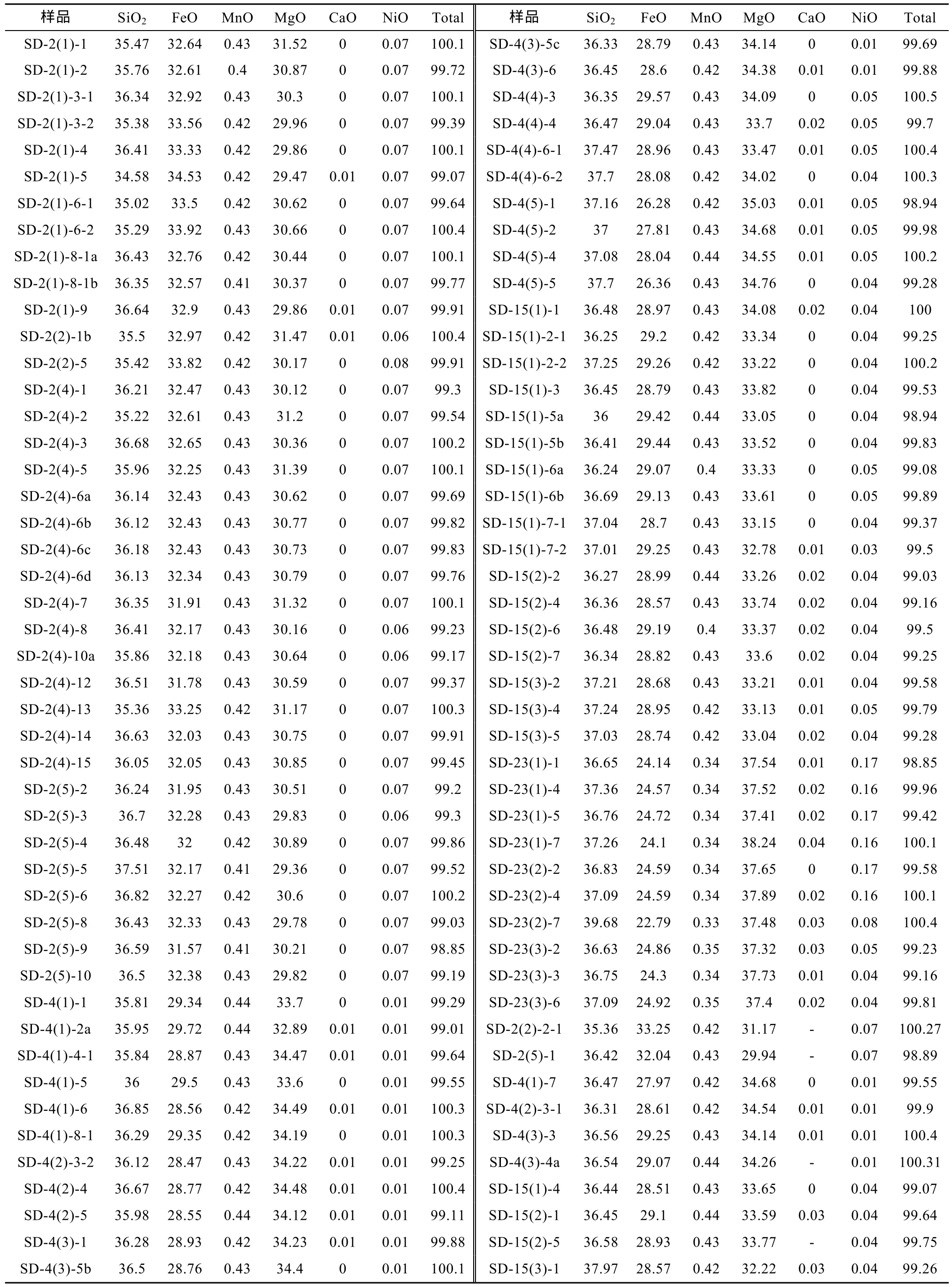
表1 济南辉长岩中橄榄石主量元素(%)电子探针分析结果Table 1 Major element compositions (%) of the olivine phenocrysts in the Jinan gabbros
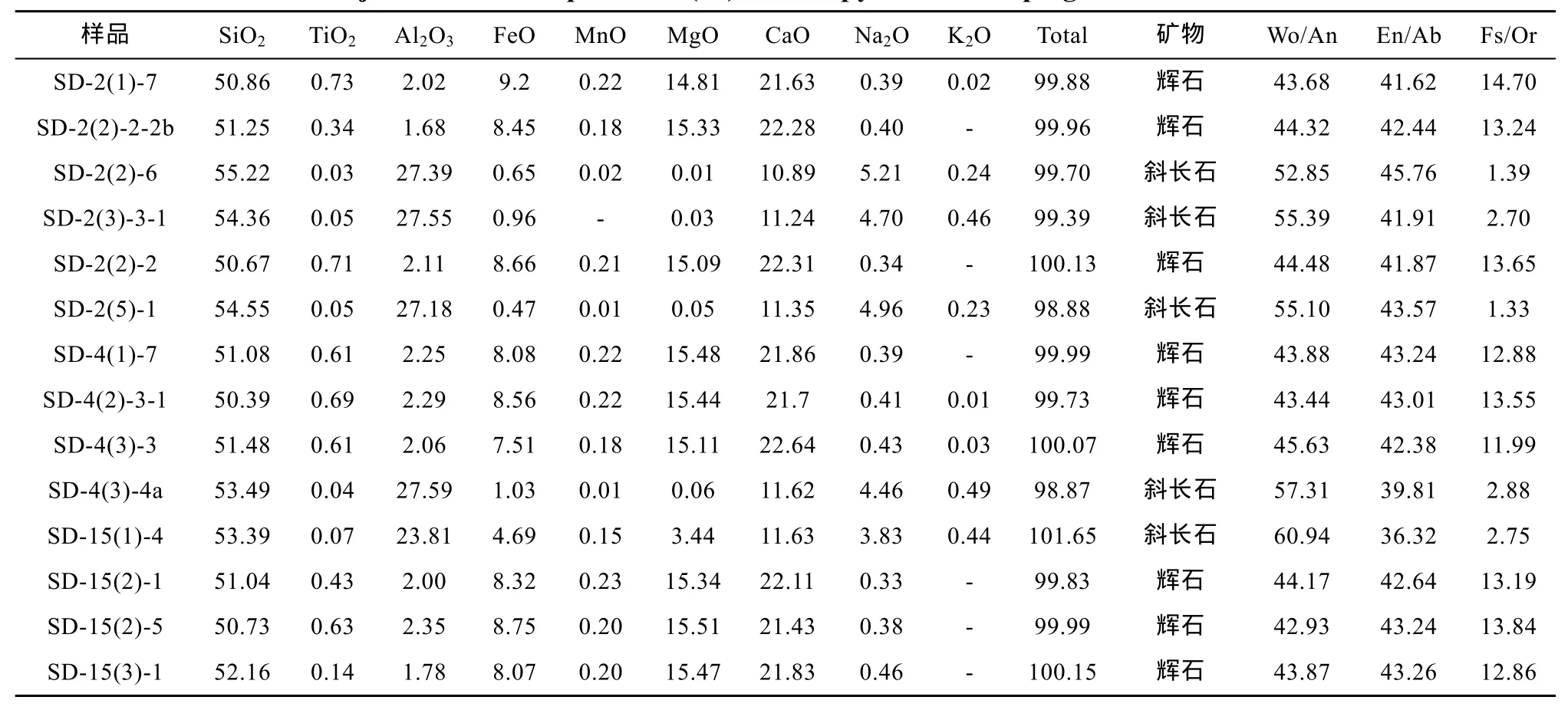
表2 橄榄石中包裹的单斜辉石和斜长石的主量元素成分(%)Table 2 Major element compositions (%) of clinopyroxene and plagioclase hosted in olivine

表3 济南辉长岩中橄榄石捕获的熔体包裹体成分(%)Table 3 Compositions of olivine-hosted melt inclusions from the Jinan gabbros
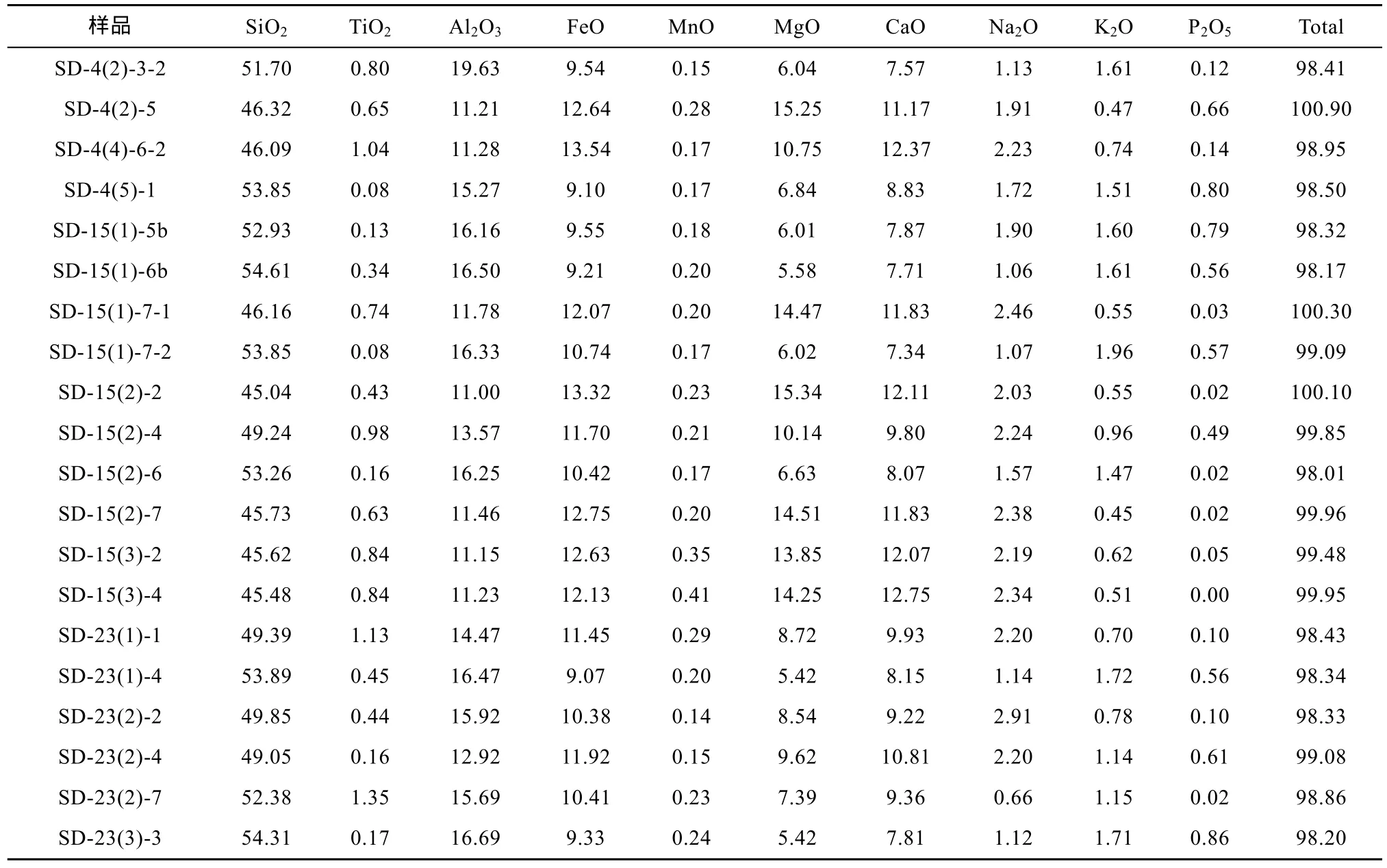
续表3:
4 讨 论
4.1分离结晶
济南辉长岩中含有橄榄石、辉石和斜长石等矿物,部分岩石样品具有较高的MgO(最高可达15%)。全岩Mg#(68.7~77.5)与其中结晶的橄榄石(Fo=60.3~74.6)不平衡, 这可能是矿物堆晶造成。部分岩石具有明显的Eu正异常(δEu达1.66)和Sr正异常(图6), 这可能与斜长石的堆晶有关。因此利用全岩成分变化来判断其岩浆演化过程可能会存在一些问题。熔体包裹体是矿物在结晶的过程中捕获的岩浆小滴, 它可以记录被捕获时岩浆的信息, 我们试图通过橄榄石中熔体包裹体的成分来重现岩浆的结晶顺序。我们测试的包裹体成分较全岩具有更高或更低的MgO, 这说明所捕获的包裹体记录了较原始和演化岩浆的信息, 能够更好的重现岩浆演化过程。在熔体包裹体氧化物与MgO关系图中(图3)可以看出, MgO>11%时, FeO、CaO/Al2O3、Na2O/K2O基本不随MgO变化而变化,CaO、Al2O3、TiO2、Na2O、K2O和SiO2与MgO呈弱的负相关性, 这说明MgO含量高于11%时, 只有橄榄石的分离结晶, 因为橄榄石基本不含Ca、Al、Na和K。当只有橄榄石结晶时, 岩浆的MgO降低, Al,Ca, Na和K将升高。因此随着橄榄石结晶残余岩浆中的CaO/Al2O3、Na2O/K2O基本不变。而辉石和斜长石的结晶会导致CaO/Al2O3比值的变化, Na2O/K2O在斜长石开始结晶时降低。MgO>11%时, 全岩具有较高的Ni、Cr且变化较快, CaO与MgO呈弱的负相关也说明了只有橄榄石的分离结晶(Huang et al.,2012)。对于那些MgO<11%的样品, CaO与MgO呈正相关, 说明有单斜辉石的分离结晶。TiO2在MgO>10%时基本不变, 而在MgO低于10%时快速降低, 这可能是钛铁矿的分离结晶造成的, 在岩石薄片中也能观察到钛铁矿晶体(图2)。Na2O/K2O比值在MgO为10%时开始下降, 说明有斜长石开始分离结晶, 而熔体中的CaO/Al2O3比值及Al2O3持续上升可能是岩浆演化主要受单斜辉石的分离结晶控制。CaO 和CaO/Al2O3比值在MgO<8%时降低速度变缓, 同时Al2O3呈现下降趋势, 可能是斜长石的大量分离结晶造成的, 而SiO2持续升高可能是有富硅熔体加入造成的。结合岩相学特征, 我们认为济南辉长岩的结晶顺序为: 橄榄石→单斜辉石→钛铁矿→斜长石。
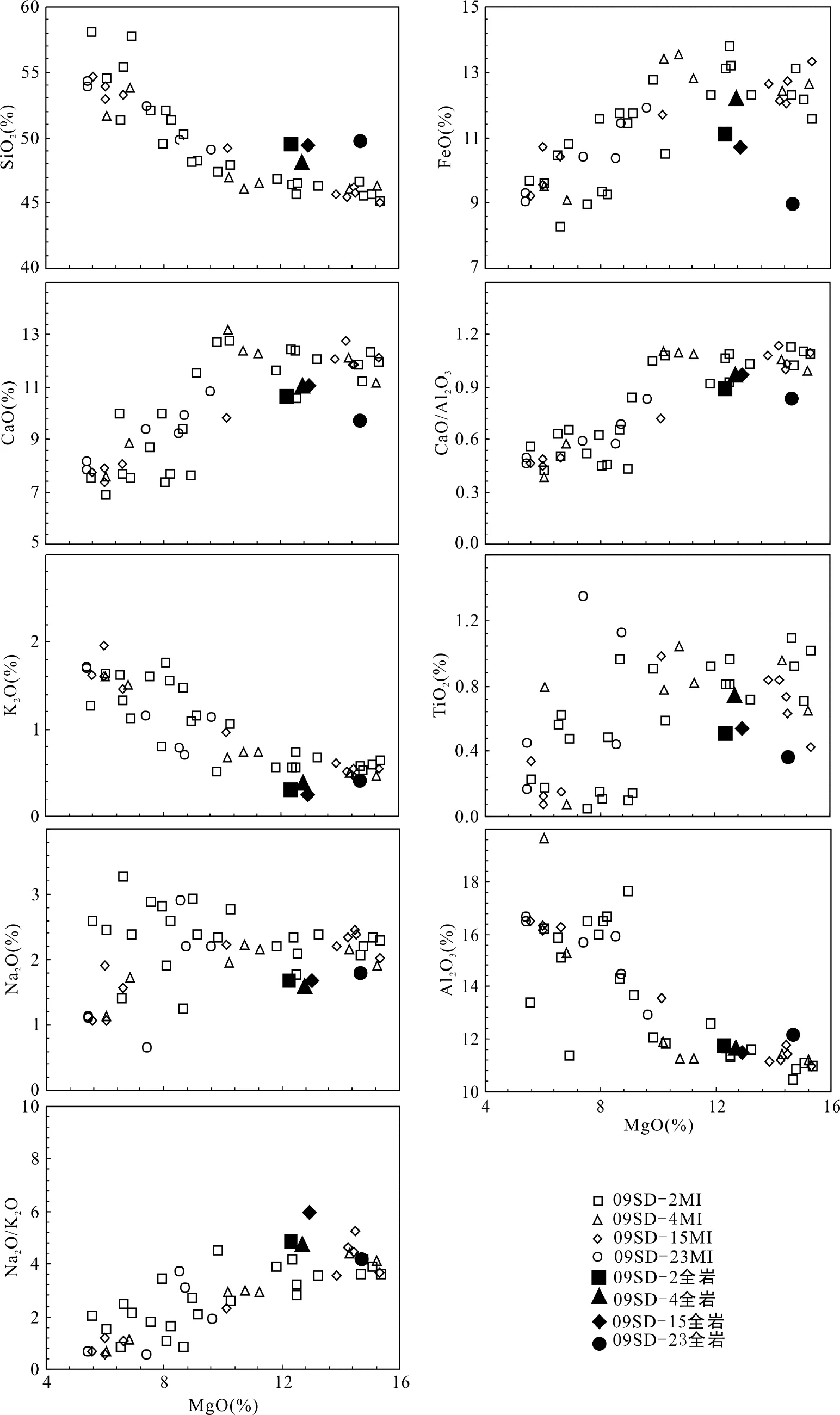
图3 MgO与SiO2、FeO、CaO、CaO/Al2O3、K2O、TiO2、Na2O、Al2O3、Na2O/K2O关系图(全岩数据来自于Guo et al. 2013; MI(melt inclusions). 熔体包裹体)Fig.3 Plots of MgO vs. SiO2, FeO, CaO, CaO/Al2O3, K2O, TiO2, Na2O, Al2O3and Na2O/K2O and for melt inclusions and whole rocks from the Jinan gabbros
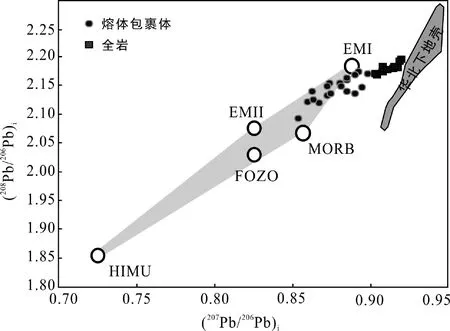
图4 熔体包裹体(207Pb/206Pb)i-(208Pb/206Pb)i关系图(底图据 Saal et al. 1998; EMI, EMII, FOZO, HIMU和MORB端元组分据Yurimoto et al., 2004; 全岩数据来自于Zhang et al., 2004; Yang et al., 2012; 华北下地壳数据来自Liu et al., 2004b)Fig.4 (207Pb/206Pb)ivs. (208Pb/206Pb)idiagram for melt inclusions from the Jinan gabbros
4.2地壳混染
来源于地幔的岩浆在上升侵位过程中或在地壳岩浆房停留时很容易受到地壳的同化混染, 而侵入岩一般在岩浆房中的停留时间更长, 所以受到地壳同化混染的可能性更大。济南辉长岩的Zr/Nb比值与εNd(t)和εHf(t)负相关, 说明济南辉长岩在岩浆演化过程中受到了高Zr/Nb比值的壳源物质(如富锆石的长英质火成岩或沉积物)的同化混染(Guo et al.,2013)。济南辉长岩具有负的εNd(t)值和低的87Sr/86Sr比值, 且亏损Th、U(图6)和高的Th/U、Nb/Ta比值,低的87Sr/86Sr比值可以排除上地壳的混染。下地壳岩石具有低的Th和U 含量(Rudnick and Gao,2003)。女山麻粒岩包体具有高的 Nb/Ta、Zr/Hf和Th/U比值和低的εNd(t)和87Sr/86Sr 比值, 具有华北克拉通太古代基底物质的性质, 可以用来代表华北克拉通中生代下地壳组分特征(Huang et al., 2004),因此济南辉长岩可能受到了下地壳物质的作用。济南辉长岩具有低的放射性Nd-Pb同位素, 高的放射性Sr, 富集大离子亲石元素, 亏损高场强元素(图6),这些特征也说明其可能与下地壳物质的加入有关(Zhang et al., 2004)。
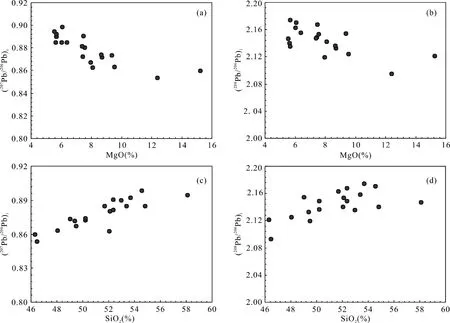
图5 熔体包裹体中Pb同位素与MgO和SiO2关系图Fig.5 Plots of Pb isotope vs. MgO and SiO2for melt inclusions from the Jinan gabbros
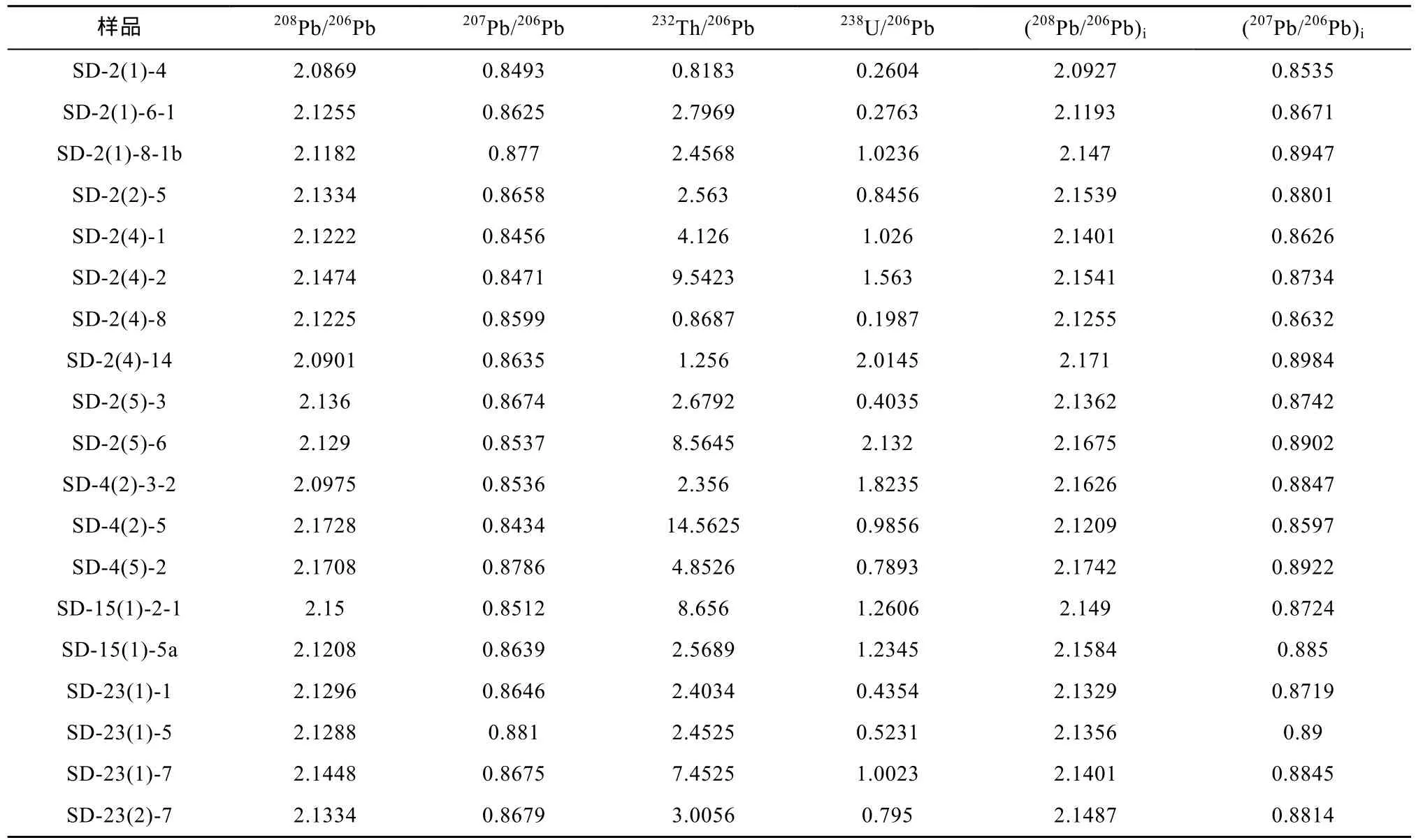
表4 济南辉长岩中熔体包裹体的Pb同位素组成Table 4 Pb isotope compositions of melt inclusions from the Jinan gabbros

图6 济南辉长岩微量元素原始地幔标准化蛛网图(原始地幔值据McDonough and Sun, 1995; 济南辉长岩数据来自Guo et al., 2013; 费县玄武岩来自Gao et al., 2008)Fig.6 Primitive mantle normalized trace element spider diagram of the Jinan gabbros
我们对橄榄石中熔体包裹体数据进行CIPW标准矿物计算, 结果显示熔体包裹体中MgO>10%时有橄榄石和霞石标准矿物的存在, 为硅不饱和熔体;而MgO<10%时有石英标准矿物分子存在(图7), 为硅饱和熔体, 因此济南辉长岩的母岩浆在岩浆作用过程中由硅不饱和岩浆演变为硅饱和岩浆。正常的结晶分异过程中硅不饱和熔体不能演化为硅饱和熔体(Tuttle and Bowen, 1958; Philpotts and Ague, 2009),只有硅饱和熔体的加入才会导致这种结果。济南辉长岩中同时含有锆石和斜锆石。锆石与橄榄石和斜锆石中δ18O存在不平衡, 及εNd(t)、εHf(t)与δ18O负相关说明橄榄石结晶于硅不饱和的封闭体系, 而锆石结晶于硅饱和的开放体系, 可能是下地壳富含δ18O的长英质组分的加入造成的(Yang et al., 2012;Guo et al., 2013)。熔体包裹体的CaO/Al2O3、Na2O/K2O在硅不饱和岩浆中保持恒定也说明早期处于封闭体系。后期SiO2快速升高, 封闭体系中正常的分离结晶作用很难使SiO2如此快速的升高。部分Fo较低的橄榄石中包裹有辉石和斜长石矿物(表3, 图2), 辉石中包裹有斜长石晶体(图2d), 这说明岩浆可能经历了多期次的分离结晶, 封闭体系中橄榄石结晶早于辉石和斜长石, 只有处于开放体系中有新岩浆的注入, 导致橄榄石重新开始结晶, 初始岩浆中结晶的辉石和斜长石才有可能被包裹在橄榄石中, 因此济南岩体可能经历了多期次岩浆注入或者地壳混染。熔体包裹体的MgO和SiO2与Pb同位素具有良好的相关性。MgO含量高的熔体包裹体具有较低的(208Pb/206Pb)i和(207Pb/206Pb)i(图5a、b)。高MgO含量Pb同位素组成更接近原生岩浆, 下地壳具有较高的(208Pb/206Pb)i和(207Pb/206Pb)i, 随着地壳混染程度增加(208Pb/206Pb)i、(207Pb/206Pb)i升高。SiO2与Pb同位素的关系说明随着地壳混染程度增加(208Pb/206Pb)i、(207Pb/206Pb)i升高, 熔体中SiO2含量升高逐步演变为硅饱和岩浆。地壳混染程度的增加也会导致橄榄石多期次的结晶, 因此橄榄石中会包裹更早期次结晶的辉石和斜长石。
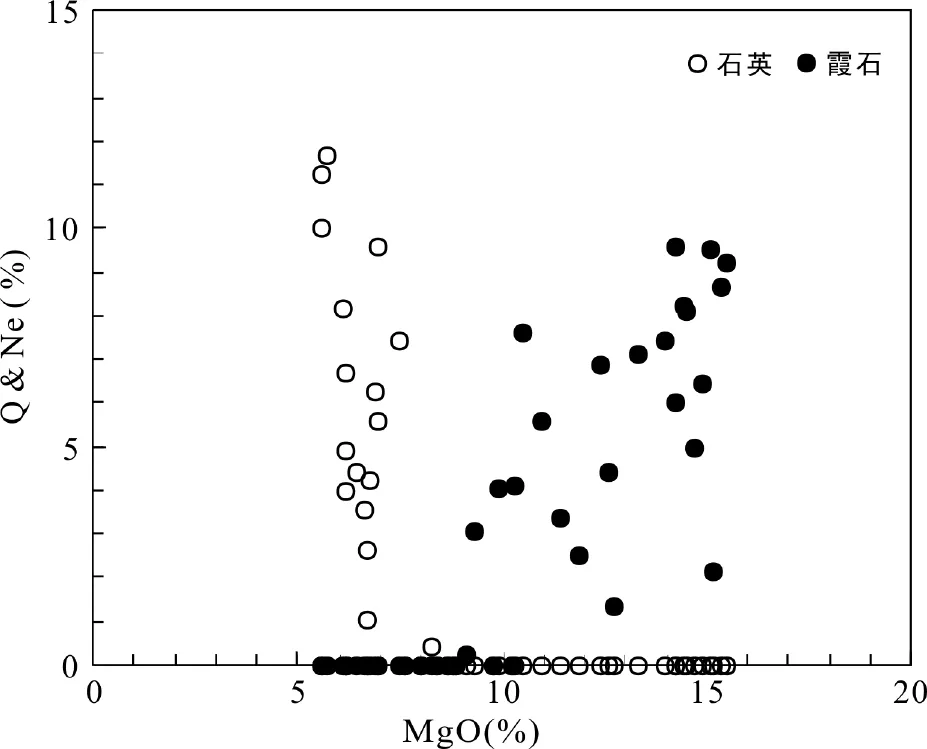
图7 熔体包裹体标准矿物分子计算(Q(quartz). 石英;Ne(nepheline). 霞石)Fig.7 CIPW norm calculation for melt inclusions from the Jinan gabbros
4.3地幔源区特征
济南辉长岩的全岩Pb同位素组成(206Pb/204Pb)i=16.56~17.018, (207Pb/204Pb)i=15.216~17.378,(208Pb/204Pb)i=36.29~36.94(Zhang et al., 2004; Yang et al., 2012)与EMI的Pb同位素组成相似(Zinder and Hart, 1986)。较全岩Pb同位素组成(208Pb/206Pb)i= 2.1678~2.1962, (207Pb/206Pb)i=0.9031~0.9192(Zhang et al. 2004; Yang et al. 2012), 橄榄石中熔体包裹体的Pb同位素(208Pb/206Pb)i=2.0927~2.1742, (207Pb/206Pb)i= 0.8535~0.8984, 具有更大的变化范围。熔体包裹体Pb同位素说明其地幔源区有EMI的贡献也可能有EMII的参与。熔体包裹体的207Pb/206Pb较全岩偏低, 可能是橄榄石中的熔体包裹体记录了更加接近原生岩浆的Pb同位素组成, 而全岩Pb同位素组成可能受到后期同化混染的影响, 使其207Pb/206Pb比值升高。全岩Pb同位素只表现出EMI地幔源区特征, 掩盖了EMII的贡献。高MgO的熔融包裹体具有更接近EMII的Pb同位素组成(图4, 5), 说明其地幔源区有EMII参与, 随地壳混染程度增加EMII特征逐渐被掩盖。
辉石岩部分熔融形成的熔体结晶出的橄榄石具有低MnO、CaO含量、高NiO含量、高Fe/Mn比值的特征(Sobolev et al., 2005, 2007; Herzberg et al.,2014)。济南辉长岩中橄榄石具有较低的CaO(<0.1%)含量, 可能是由于扩散作用造成的。Ca在橄榄石中为不相容元素, 而在单斜辉石中为相容元素, 侵入岩中橄榄石与辉石接触, 橄榄石中Ca会扩散至辉石中, 导致橄榄石中CaO<0.1%(Kent, 2008)。Fo介于65~69的橄榄石的Fe/Mn、Ni与Fo>70的橄榄石不在同一演化线上, 这可能是钛铁矿结晶使Fe快速降低造成的。钛铁矿结晶会使熔体中Mn含量降低, 但同时有其他矿物(橄榄石、单斜辉石)大量结晶使熔体中Mn升高(图8b)。钛铁矿的分离结晶会干扰源区母岩判别, 为此我们只选取Fo>70橄榄石来讨论其源区岩性。Fo介于72~75的橄榄石中具有较低的Mn(2538~2716 μg/g), 较高的Ni(307~1349 μg/g)和高的Fe/Mn比值(69.5~73.4)(图8)。Fo介于72~75的橄榄石的Mn恰好与夏威夷Loihi玄武岩基本落在同一趋势线上(图8b), 橄榄石的Ni含量与Mn的投图结果一致(图8c), 且其Fe/Mn比值刚好处于橄榄岩与辉石岩熔体的分界附近(图8d)。Loihi玄武岩被认为是橄榄岩和辉石岩部分熔融形成的(Sobolev et al., 2005), 因此济南辉长岩中较早结晶橄榄石的Fo(72~75)与Mn、Ni及Fe/Mn的关系图说明其源区不止有橄榄岩的贡献也应该有辉石岩的参与。
为了进一步限定源区岩性, 我们试图通过熔体包裹体成分来判断源区母岩的岩性。具有较低MgO的熔体包裹体受结晶分异和同化混染的影响很难反映源区特征。MgO<8%时, SiO2和TiO2明显偏离橄榄岩和辉石岩区域(图9a、c), 这可能是下地壳长英质组分加入的结果, 此外钛铁矿的分离结晶导致TiO2降低。MgO较高的熔体包裹体相对比较接近母岩浆组分, 受结晶分异和同化混染的影响较小, 能更好的反映源区特征。高MgO的熔体包裹体基本都落在橄榄岩和辉石岩的重叠区域(图9), 这一特征也说明其源区可能有橄榄岩和辉石岩的贡献。
5 结 论
本文通过济南辉长岩的橄榄石化学组成, 熔体包裹体主量元素及Pb同位素组成结合前人已发表全岩主微量元素和同位素数据, 得出如下认识:
(1) 济南辉长岩由硅不饱和岩浆逐渐演化为硅饱和岩浆, 演化过程中岩浆体系不是封闭的, 有下地壳长英质熔体的加入。
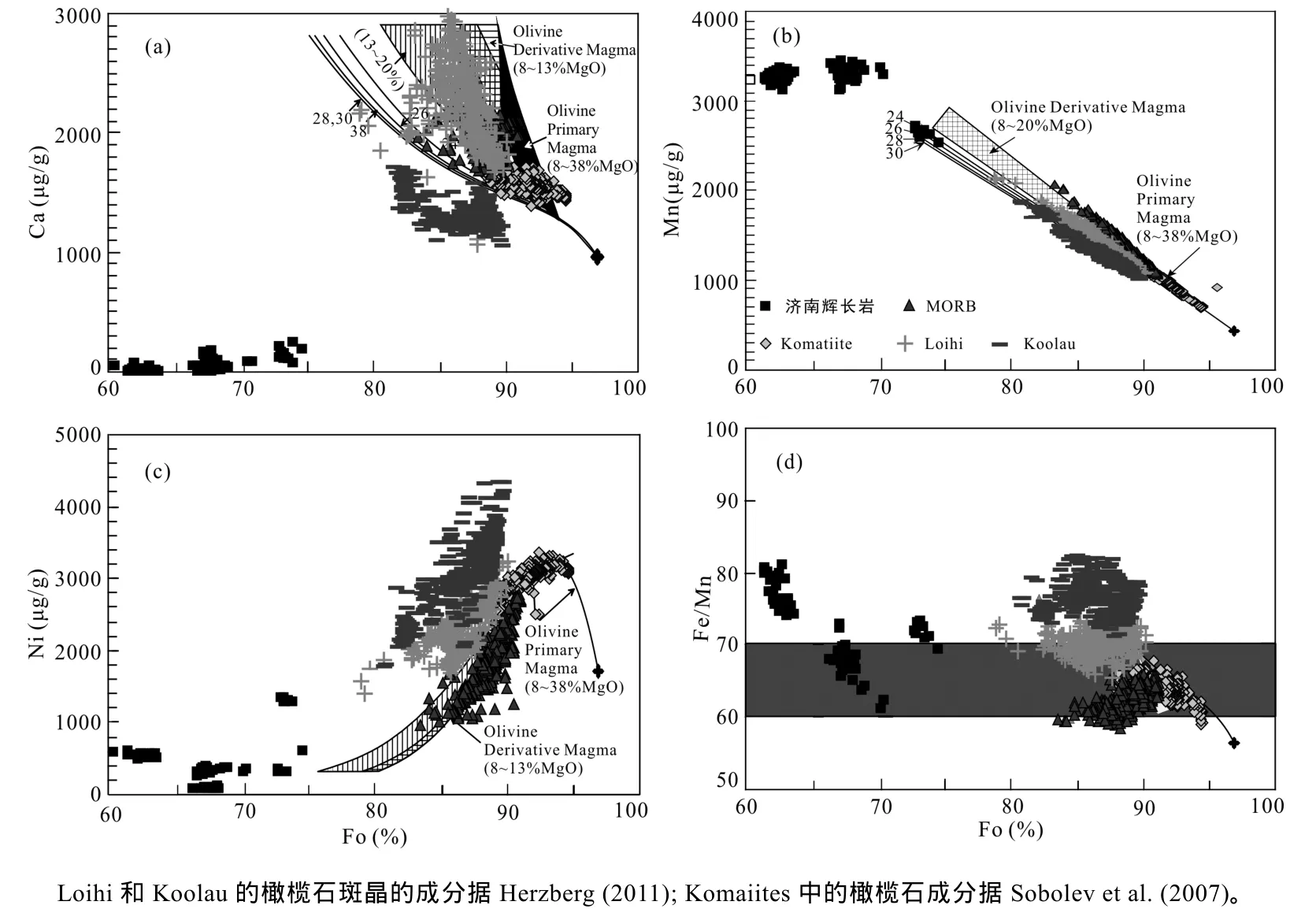
图8 济南辉长岩橄榄石斑晶的组成(底图据Herzberg, 2011)Fig.8 Plots of Ca, Mn, Ni and Fe/Mn against Fo for the olivines from the Jinan gabbros
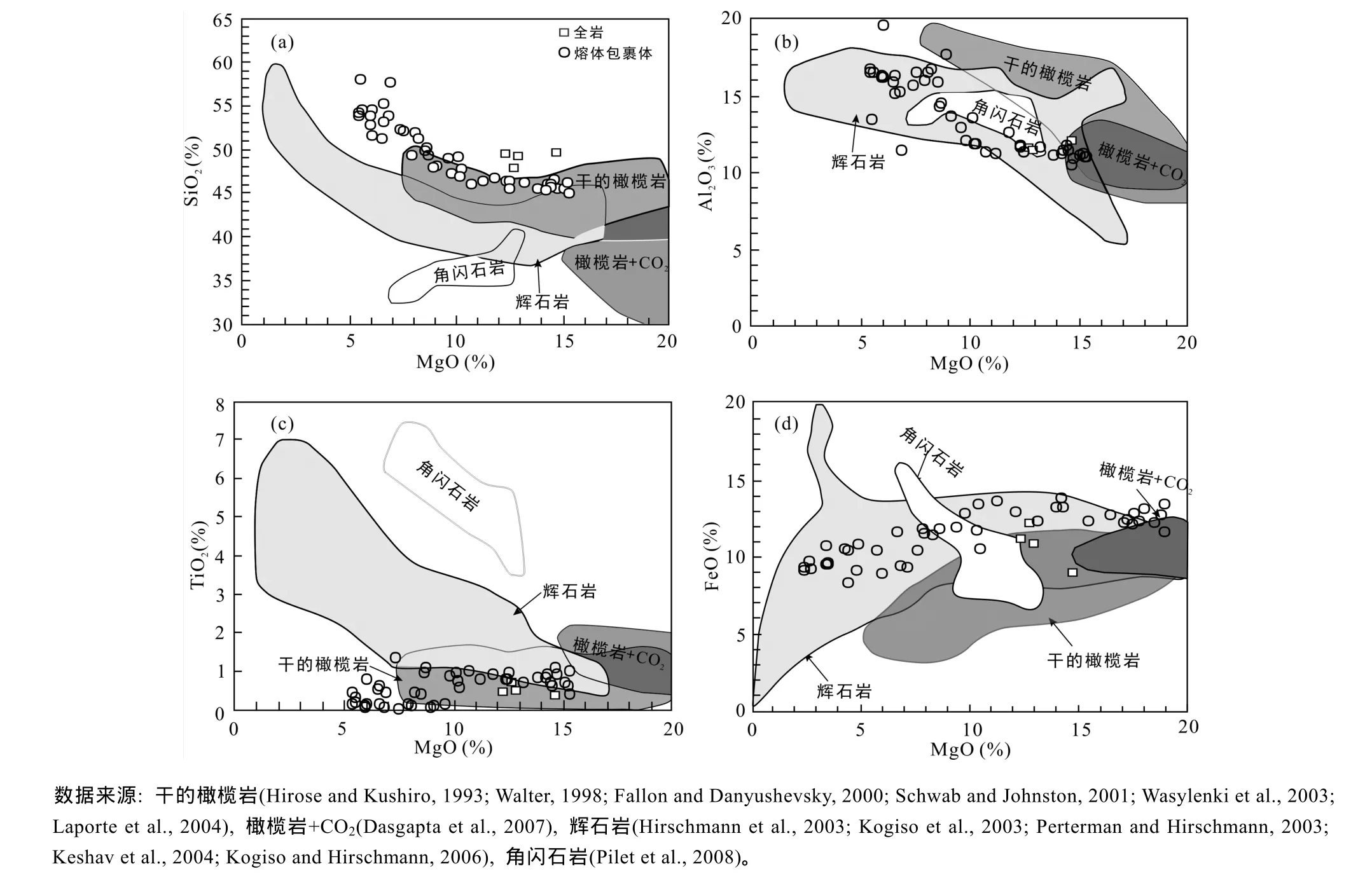
图9 济南辉长岩与超镁铁质岩石高压实验产生的部分熔融体之间的比较Fig.9 Comparison of the Jinan gabbros with the high-pressure experimental partial melts of various ultramafic rocks
(2) 熔体包裹体Pb同位素较全岩更靠近EMII,尤其是高MgO的熔体包裹体, 表明全岩Pb同位素是受到地壳混染后的成分, 因此济南辉长岩的地幔源区有EMI和EMII的贡献, 全岩遭受同化混染后掩盖了EMII的贡献。
致谢: 衷心感谢中国科学院广州地球化学研究所熊小林研究员和吉林大学葛文春教授两位审稿专家对本文提出了建设性的意见和建议。此外, 吴蕾女士在橄榄石挑选, 加热, 熔体包裹体制备及测试中给予悉心的指导和帮助, 我们在此向其表示衷心的感谢。
参考文献(References):
邓晋福, 莫宣学, 赵海玲, 罗照华, 杜杨松. 1994. 中国东部岩石圈根去根作用与大陆活化——东亚型大陆动力学模式研究计划. 现代地质, 8(3): 349-356.
范蔚茗, 郭锋. 2005. 华北地区晚中生代镁铁质岩浆作用及其地球动力学背景. 大地构造与成矿学, 29(1): 44-55.
刘建强, 任钟元. 2013. 玄武岩源区母岩的多样性和识别特征: 以海南岛玄武岩为例. 大地构造与成矿学,37(3): 471-488.
牛耀岭. 2005. 玄武岩浆起源和演化的一些基本概念以及对中国东部中-新生代基性火山岩成因的新思路. 高校地质学报, 11(1): 9-46.
山东省地质矿产局. 1991. 山东区域地质志. 北京: 地质出版社: 300-325.
张宏福, 英基丰, 徐平, 马玉光. 2004. 华北中生代玄武岩中地幔橄榄石捕虏晶: 对岩石圈地幔置换过程的启示. 科学通报, 49(8): 784-789.
张宏福. 2009. 橄榄岩-熔体相互作用: 克拉通型岩石圈地幔能够被破坏之关键. 科学通报, 54(14): 2008-2026.
钟军伟, 黄小龙. 2012. 鲁西早白垩世基性侵入岩的锆石Hf同位素组成变化及其成因. 大地构造与成矿学,36(4): 572-580.
Aulbach S, Griffin W L, Pearson N J, O'Reilly S Y, Kivi K and Doyle B J. 2004. Mantle formation and evolution,Slave Craton: Constraints from HSE abundances and Re-Os isotope systematics of sulfide inclusions in mantle xenocrysts. Chemical Geology, 208(1): 61-88.
Aulbach S, Griffin W L. Pearson N J, O'Reilly S Y and Kivi K. 2005. Os-Hf-Nd isotope constraints on subcontinental lithospheric mantle evolution, Slave Craton (Canada). Geochimica et Cosmochimica Acta, 69: 284-295.
Aulbach S, Griffin W L, Pearson N J, O'Reilly S Y, Kivi K and Doyle B J. 2007. Lithosphere formation in the central Slave Craton (Canada): Plume subcretion or lithosphere accretion? Contributions to Mineralogy and Petrology, 154(4): 409-427.
Chen B, Jahn B M, Arakawa Y and Zhai M G. 2004. Petrogenesis of the Mesozoic intrusive complexes from the southern Taihang Orogen, North China Craton,elemental and Sr-Nd-Pb isotopic constraints. Contributions to Mineralogy and Petrology, 148: 489-501.
Dasgupta R, Hirschmann M M and Smith N D. 2007. Partial melting experiments of peridotite+CO2at 3 GPa and genesis of alkalic ocean island basalts. Journal of Petrology, 48(11): 2093-2124.
Deng J F, Su S G, Niu Y L, Liu C, Zhao G C, Zhao X G,Zhou S and Wu Z X. 2007. A possible model for the lithospheric thinning of North China Craton: Evidence from the Yanshanian (Jura-Cretaceous) magmatism and tectonism. Lithos, 96: 22-35.
Falloon T J and Danyushevsky L V. 2000. Melting of refractory mantle at 1.5, 2 and 2.5 GPa under anhydrous and H2O-undersaturated conditions: Implications for the petrogenesis of high-Ca boninites and the influence of subduction components on mantle melting. Journal of Petrology, 41(2): 257-283.
Fan W M, Zhang H F, Baker J, Javis K E, Mason P R D and Menzies M A. 2000. On and off the North China craton,where is the Archean keel? Journal of Petrology, 41: 933-950.
Gao S, Zhang B R, Jin Z M, Kern H, Luo T C and Zhao Z D. 1998. How mafic is the lower continental crust? Earth and Planetary Science Letters, 161: 101-117.
Gao S, Rudnick R L, Carlson R W, McDonough W F and Liu Y S. 2002. Re-Os evidence for replacement of ancient mantle lithosphere beneath the North China craton. Earth and Planetary Science Letters, 198: 307-322.
Gao S, Rudnick R L, Yuan H L, Liu X M, Liu Y S, Xu W L,Ling W L, Ayers J, Wang X C and Wang Q H. 2004. Recycling lower continental crust in the North China craton. Nature, 432: 892-897.
Gao S, Rudnick R L, Xu W L, Yuan H L and Ling W L. 2008. Recycling deep cratonic lithosphere and generation of intraplate magmatism in the North China Craton. Earth and Planetary Science Letters, 270: 41-53.
Guo F, Fan W M, Wang Y J and Lin G. 2001. Late Mesozoicmafic intrusive complexes in North China Block,constraints on the nature of subcontinental lithospheric mantle. Physics and Chemistry of the Earth, 26: 759-771.
Guo F, Guo J T, Wang C Y, Fan W M, Li C W, Zhao L, Li H X and Li J Y. 2013. Formation of mafic magmas through lower crustal AFC processes—An example from the Jinan gabbroic intrusion in the North China Block. Lithos, 179: 157-174.
Griffin W L, Andi Z, O'Reilly S Y and Ryan C G. 1998. Phanerozoic evolution of the lithosphere beneath the Sino-Korean craton // Flower M F J, Chung S L, Lo C H and Lee T Y. Mantle Dynamics and Plate Interactions in East Asia. Washington: American Geophysical Union Monograph: 107-126.
Herzberg C. 2011. Identification of source lithology in the Hawaiian and Canary Islands: Implications for origins. Journal of Petrology, 52: 113-146.
Herzberg C, Cabral R A, Jackson M G, Vidito C, Day J M D and Hauri E H. 2014. Phantom Archean crust in mangaia hotspot lavas and the meaning of heterogenous mantle. Earth and Planetary Science Letters, 396: 97-106.
Hirose K and Kushiro I. 1993. Partial melting of dry peridotites at high pressures: Determination of compositions of melts segregated from peridotite using aggregates of diamond. Earth and Planetary Sciences Letters, 114: 477-489.
Hirschmann M M, Kogiso T, Baker M B and Stolper E M. 2003. Alkalic magmas generated by partial melting of garnet pyroxenite. Geology, 31: 481-484.
Huang X L, Xu Y G and Liu D Y. 2004. Geochronology,petrology and geochemistry of the granulite xenoliths from Nushan, east China: Implication for a heterogeneous lower crust beneath the Sino-Korean Craton. Geochimica et Cosmochimica Acta, 68: 127-149.
Huang X L, Zhong J W and Xu Y G. 2012. Two tales of the continental lithospheric mantle prior to the destruction of the North China Craton, Insights from Early Cretaceous mafic intrusions in western Shandong, East China. Geochimica et Cosmochimica Acta, 96: 193-214.
Kent A J R. 2008. Melt inclusions in basaltic and related volcanic rocks. Reviews in Mineralogy and Geochemistry, 69(1): 273-331.
Keshav S, Gudfinnsson G, Sen G and Fei Y. 2004. High-pressure melting experiments on garnet clinopyroxenite and the alkalic to tholefitic transition in ocean-island basalts. Earth and Planetary Sciences Letters, 223: 365-379.
Kogiso T and Hirschmann M. 2006. Partial melting experiments of bimineralic eclogite and the role of recycled mafic oceanic crust in the genesis of ocean island basalts. Earth and Planetary Sciences Letters,249: 188-199.
Kogiso T, Hirschmann M M and Frost D J. 2003. High-pressure partial melting of garnet pyroxenite: Possible mafic lithologies in the source of ocean island basalts. Earth and Planetary Sciences Letters, 216: 603-617.
Laporte D, Toplis M J, Seyler M and Devidal J L. 2004. A new experimental technique for extracting liquids from peridotite at very low degrees of melting: Application to partial melting of depleted peridotite. Contributions to Mineralogy and Petrology, 146: 463-484.
Liu D Y, Nutman A P, Compston W, Wu J S and Shen Q H. 1992. Remnants of greater-than-or-equal-to 3800 Ma crust in the Chinese part of the Sino-Korean Craton. Geology, 20: 339-342.
Liu M, Cui X J and Liu F T. 2004a. Cenozoic rifting and volcanism in eastern China: A mantle dynamic link to the Indo-Asian collision? Tectonophysics, 393: 29-42.
Liu Y S, Gao S, Yuan H L, Zhou L, Liu X M, Wang X C, Hu Z C and Wang L S. 2004b. U-Pb zircon ages and Nd, Sr,and Pb isotopes of lower crustalxenoliths from North China Craton: Insights on evolution of lower continental crust. Chemical Geology, 211: 87-109.
Liu Y S, Gao S, Kelemen P B and Xu W L. 2008. Recycled crust controls contrasting source compositions of Mesozoic and Cenozoic basalts in the North China Craton. Geochimica et Cosmochimica Acta, 72: 2349-2376.
McDonough W F and Sun S S. 1995. The composition of the earth. Chemical Geology, 120: 223-253.
Menzies M A, Fan W and Zhang M. 1993. Palaeozoic and Cenozoic lithoprobes and the loss of >120 km of Archaean lithosphere, Sino-Korean craton, China. Geological Society, London, Special Publications, 76: 71-81.
Menzies M A and Xu Y G. 1998. Geodynamics of the North China Craton // Flower M, Chung S L, Lo C H and Lee T Y. Mantle Dynamics and Plate Interactions in EastAsia. Washington: American Geophysical Union Monograph: 155-165.
Menzies M A, Xu Y G., Zhang H F and Fan W M. 2007. Integration of geology, geophysics and geochemistry: A key to understanding the North China Craton. Lithos,96: 1-21.
Norman M D, Garcia M O, Vadim S. Kamenetsky R L and Nielsen. 2002. Olivine-hosted melt inclusions in Hawaiian picrites: Equilibration, melting, and plume source characteristics. Chemical Geology, 183: 143-168.
Pertermann M and Hirschmann M. 2003. Anhydrous partial melting experiments on MORB-like eclogite: Phase relations, phase compositions and mineral-melt partitioning of major elements at 2-3 GPa. Journal of Petrology, 44: 2173-2201.
Pilet S, Baker M B and Stolper E M. 2008. Metasomatized lithosphere and the origin of alkaline lavas. Science,320: 916-919.
Philpotts A R and Ague J J. 2009. Principles of Igneous and Metamorphic Petrology. Cambridge University Press: 194-220.
Qian S P, Ren Z Y, Zhang L, Hong L B and Liu J Q. 2015. Chemical and Pb isotope composition of olivine-hosted melt inclusions from the Hannuoba basalts, North China Craton: Implications for petrogenesis and mantle source. Chemical Geology, 401: 111-125.
Ren Z Y, Ingle S, Takahashi E, Hirano N and Hirata T. 2005. The chemical structure of the Hawaiian mantle plume. Nature, 436: 837-840.
Rudnick R L and Gao S. 2003. Composition of the continental crust // Carlson R W. Treatise on Geochemistry 3, The mantle and core. New York: Elsevier: 1-70.
Saal A E. 1998. Pb isotopic variability in melt inclusions from oceanic island basalts, Polynesia. Science, 282: 1481-1484.
Schwab B E and Johnston A D. 2001. Melting systematics of modally variable, compositionally intermediate peridotites and the effects of mineral fertility. Journal of Petrology,42(10): 1789-1811.
Sobolev A V. 1996. Melt inclusions in minerals as a source of principle petrological information. Petrology, 4(3): 209-220.
Sobolev A V, Hofmann A W and Nikogosian I K. 2000. Recycled oceanic crust observed in ghost plagioclase within the source of Mauna Loa lavas. Nature, 404: 986-990.
Sobolev A V, Hofmann A W, Sobolev S V and Nikogosian I K. 2005. An olivine-free mantle source of Hawaiian shield basalts. Nature, 434: 590-597.
Sobolev A V, Hofmann A W, Kuzmin D V, Yaxley G M,Arndt N T, Chung S L, Danyushevsky, L V, Elliott T,Frey, F A, Garcia M O, Gurenko A A, Kamenetsky V S,Kerr A C, Krivolutskaya N A, Matvienkov V V,Nikogosian I K, Rocholl A, Sigurdsson I A,Sushchevskaya N M and Teklay M. 2007. The amount of recycled crust in sources of mantle-derived melts. Science, 316: 412-417.
Tang Y J, Zhang H F and Ying J F. 2006. Asthenosphere-lithospheric mantle interaction in an extensional regime: Implication from the geochemistry of Cenozoic basalts from Taihang Mountains, North China Craton. Chemical Geology, 233: 309-327.
Tuttle O F and Bowen N L. 1958. Origin of Granite in the Light of Experimental Studies in the System NaAlSi3O8-KAlSi3O8-SiO2-H2O. Geological Society of America Memoirs: 1-146.
Walter M J. 1998. Melting of garnet peridotite and the origin of komatiite and depleted lithosphere. Journal of Petrology, 39: 29-60.
Wang Z R and Gaetani G A. 2008. Partitioning of Ni between olivine and siliceous eclogite partial melt: Experimental constraints on the mantle source of Hawaiian basalts. Contributions to Mineralogy and Petrology, 156: 661-678.
Wasylenki L E, Baker M B, Kent A J R and Stolper E M. 2003. Near-solidus melting of the shallow upper mantle: Partial melting experiments on depleted peridotite. Journal of Petrology, 44: 1163-1191.
Wu F Y, Walker R J, Ren X, Sun D and Zhou X. 2003. Osmium isotopic constraints on the age of lithospheric mantle beneath northeastern China. Chemical Geology,196: 107-129.
Wu F Y, Lin J Q, Wilde S A, Zhang X and Yang J H. 2005. Nature and significance of the Early Cretaceous giant igneous event in eastern China. Earth and Planetary Science Letters, 233: 103-119.
Wu F Y, Walker R J, Yang Y H, Yuan H L and Yang J H. 2006. The chemical-temporal evolution of lithospheric mantle underlying the North China Craton. Geochimica et Cosmochimica Acta, 70: 5013-5034.
Xu Y G, Ma J L, Frey F A, Feigenson M D, Liu J F. 2005. Role of lithosphere-asthenosphere interaction in the genesis of Quaternary alkali and tholeiitic basalts from Datong, western North China Craton. Chemical Geology, 224: 247-271.
Xu Y G. 2001. Thermo-tectonic destruction of the Archaean lithospheric keel beneath the Sino-Korean Craton in China: Evidence, timing and mechanism. Physics and Chemistry of the Earth (A), 26: 747-757.
Xu Y G, Ma J L, Huang X L, Iizuka Y, Chung S L, Wang Y B and Wu X Y. 2004. Early Cretaceous gabbroic complex from Yinan, Shandong province: Petrogenesis and mantle domains beneath the North China Craton. International Journal of Earth Sciences, 93: 1025-1041.
Xu W L, Gao S, Wang Q H, Wang D Y and Liu Y S. 2006. Mesozoic crustal thickening of the eastern North China Craton: Evidence from eclogite xenoliths and petrologic implications. Geology, 34: 721-724.
Yang J H, Wu F Y, Wilde S A, Belousova E and Griffin W L. 2008. Mesozoic decratonization of the North China block. Geology, 36(6): 467-470.
Yang D B, Xu W L, Pei F P, Yang C H and Wang Q H. 2012. Spatial extent of the influence of the deeply subducted South China Block on the southeastern North China Block: Constraints from Sr-Nd-Pb isotopes in Mesozoic mafic igneous rocks. Lithos, 136: 246-260.
Yurimoto H, Kogiso T, Abe K, Barsczus H G, Utsunomiya A and Maryuama S. 2004. Lead isotopic compositions in olivine-hosted melt inclusions from HIMU basalts and possible link to sulfide components. Physics of the Earth and Planetary Interiors, 146: 231-242.
Zhang L, Ren Z Y, Nichols A R L, Zhang Y H, Zhang Y,Qian S P and Liu J Q. 2014. Lead isotope analysis of melt inclusions by LA-MC-ICP-MS. Journal of Analytical Atomic Spectrometry, 29: 1393-1405.
Zhang H F, Sun M, Zhou X H, Fan W M, Zhai M G and Yin J F. 2002. Mesozoic lithosphere destruction beneath the North China Craton: Evidence from major-,trace-element and Sr-Nd-Pb isotope studies of Fangcheng basalts. Contributions to Mineralogy and Petrology, 144: 241-253.
Zhang H F, Sun M, Zhou X H, Zhou M F, Fan W M and Zheng J P. 2003. Secular evolution of the lithosphere beneath the eastern North China Craton: Evidence from Mesozoic basalts and high-Mg andesites. Geochimica et Cosmochimica Acta, 76: 4373-4387.
Zhang H F, Sun M, Zhou M F, Fan W M, Zhou X H and Zhai M G. 2004. Highly heterogeneous late Mesozoic lithospheric mantle beneath the North China Craton: Evidence from Pb-Sr-Nd isotopic systematics of mafic igneous rocks. Geological Magazine. 141: 55-62.
Zhang H F, Goldstein S L, Zhou X H, Sun M, Zheng J P and Cai Y. 2008. Evolution of subcontinental lithospheric mantle beneath eastern China: Re-Os isotopic evidence from mantle xenoliths in Paleozoic kimberlites and Mesozoic basalts. Contributions to Mineralogy and Petrology, 155: 271-293.
Zhai M G, Fan Q C, Zhang H F, Sui J L, Shao J A. 2007. Lower crustal processes leading to Mesozoic lithospheric thinning beneath eastern North China: Underplating,replacement and delamination. Lithos, 96: 36-54.
Zhao G C, Wilde S A, Cawood P A, Sun M. 2001. Archean blocks and their boundaries in the North China Craton,lithological, geochemical, tructural and P-T path constraints and tectonic evolution. Precambrian Research, 107: 45-73.
Zheng J P, Griffin W L, O'Reilly S Y, Yang J S, Li T F, Zhang M, Zhang R Y and Liu J G. 2006. Mineral chemistry of peridotites from Paleozoic, Mesozoic and Cenozoic Lithosphere, Constraints on mantle evolution beneath Eastern China. Journal of Petrology, 47: 2233-2256.
Zindler A and Hart S. 1986. Chemical geodynamics. Annual Review of Earth and Planetary Sciences, 14: 493-571.
Magmatic Processes Involved in Formation of the Jinan Gabbros:Evidence from Melt Inclusions
DING Xiangli1, 2, 3, REN Zhongyuan1*, GUO Feng1, QIAN Shengping1, 2, ZHANG Le1, HUANG Xiaolong1, CHEN Linli1, ZHANG Yinhui1, HONG Lubing1, ZHANG Yan1, 2and WU Yadong1, 2
(1. State Key Laboratory of Isotope Geochemistry, Guangzhou Institute of Geochemistry, Chinese Academy of Sciences, Guangzhou 510640, Guangdong, China; 2. University of Chinese Academy of Sciences, Beijing 100049,China; 3. Institute of Tibetan Plateau Research, Chinese Academy of Sciences, Beijing 100101, China)
Abstract:We present the first analyses of major elements and Pb isotope compositions of olivine-hosted melt inclusions from the Jinan gabbros in the Early Cretaceous. The olivines in the Jinan gabbros display a relatively large compositional variation: Fo values vary from 60.3 to 74.6; Mn contents range from 2500- 3500 μg/g; Ni contents show a range of 70- 1349 μg/g and Fe/Mn ratios range from 61.2 to 83.5. Different from the olivine crystallized from partial melts of pure peridotite, the compositional variation of the olivine in the Jinan gabbros is consistent with the contribution of pyroxenite other than peridotite in the source. The melt inclusions hosted by the olivine crystals show a significant compositional variation. CIPW norm calculations indicate that melt inclusions with MgO>10% contain normative nepheline (Ne) and olivine (Ol), while melt inclusions with MgO<10% contain normative quartz (Q). The occurrence of clinopyroxene and plagioclase hosted in olivines suggests that the magmatic processes involved the formation of gabbro should be occurred in an open-system. The negative correlation between (208Pb/206Pb)i, (207Pb/206Pb)iand MgO, and positive correlation between (208Pb/206Pb)i, (207Pb/206Pb)iand SiO2, and high SiO2content of melt inclusions, indicate that felsic component from the lower crust may be involved in the magmatic processes. The Pb isotopic compositions of melt inclusions are close to EMI and extend towards an EMII-type isotopic composition,suggestive of the involvement of the EMI and EMII components during the formation of the Jinan gabbros. The CaO contents and major element compositions of melt inclusions are consistent with partial melting of the mixing of peridotite- and pyroxenite- sources.
Keywords:the Jinan gabbros; olivine; melt inclusions; Pb isotope
中图分类号:P581
文献标志码:A
文章编号:1001-1552(2016)01-0174-017
收稿日期:2015-01-27; 改回日期: 2015-03-20
第一作者简介:丁相礼(1987-), 男, 硕士研究生, 岩石地球化学专业。Email: 991592435@qq. com
通信作者:任钟元(1962-), 男, 研究员, 从事岩石学和地球化学方向研究。Email: zyren@gig.ac.cn

